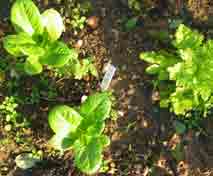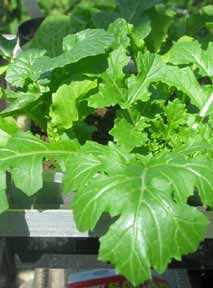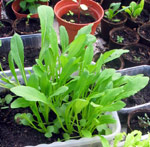Alternatives to Lettuce for All
Seasons
How can we find decent alternatives to lettuce?
Much as I love lettuce, it's nice to have a few alternatives. Lettuce can be limp or tough - see below for some of the problems - and some solutions!
There are lots of excellent lettuce varieties on offer in seed catalogues - far more than you will find in your average supermarket. If you are a lettuce lover and don't mind growing your own, you can find plenty of different types to keep you interested.
But lettuce does have its drawbacks as both as a crop to grow and as an eating experience.
Click here to go straight to alternatives to lettuce. Alternatively, read on for some reasons why you might want to find alternatives; many of them are really easy to grow - or even find!
Growing problems
Many varieties of lettuce do beautifully in the early part of the year and in the cooler, but still warm and long days of early autumn.
But in the middle of summer and any unseasonable hot spell your precious lettuce crop just bolts. Once lettuce start to bolt the flavour gets bitter and the leaves become tough and chewy.
In winter on the other hand, many lettuce varieties just give up growing and wait it out. That's if they don't succumb to the cold, or get knocked about and damaged by the wind, of course.

These crispheads are seen here growing in November. They weathered
this year's relatively mild conditions without protection and were big
enough to eat by April.
So here are a few good alternatives to lettuce. Many are very easy to grow and all provide excellent salad materials.
Also, see below (bottom of page) for some varieties of lettuce which resist the evils outlined above.
Sponsored links
Marvellous Mizuna - an oriental wonder
Alternatives to lettuce: Mizuna
First in my affections is Mizuna, which is Japanese. I chanced on this one a couple of seasons ago. It is now being promoted in quite a few seed catalogues as a good alternative to lettuce in the cold season.

It is beautifully easy to grow - always a strong recommendation, in my view! It is pleasantly crisp, with a mild leafy flavour. It's attractive, too, with fern-like leaves, not unlike dandelion or some of the oak leaf lettuces at first glance.
It can be grown as a cut-and-come-again kind of crop. Just clip the leaves from the growing plants. They'll grow back strongly in a matter of days as long as you don't overdo it.
Sow the seed in any good compost-rich growing medium and keep the seedlings well watered. Protect them from wind and any very strong sunlight. Wait until the seedlings are about 5cms or more high before trimming them for salad use.
I'm now trying out Mibuna and Mipoona which are related plant varieties. (See picture, above)
Watch out for pigeons. My local wood pigeons have now discovered my mizuna crop and have enjoyed a spring feast! You need to either net your crop effectively or put it under glass. While pigeons look charming they are almost locust-like in their ability to consume everything.

Picture right: what pigeons did to one of my plants!
For a good book on salad options for growing, Salad Leaves for All Seasons: Organic Growing from Pot to Plot is well worth checking out. Also, anything by Joy Larkcom is well worth the purchase price - or tracking down in your library!
Alternatives to lettuce:
Cabbage - not just for winter
Cabbage makes a reasonable alternative to lettuce.
There are many kinds of cabbage which do quite well in salads as long as you don't overwhelm the more subtle tastes of the other ingredients.
The youngest and tenderest leaves are best. If you do use the coarser ones, slice them really finely. Red cabbages certainly look attractive. Savoy and other drumhead varieties are good in coleslaw but even looseleaf kinds can be used in moderation in salads.
Cabbages need fairly alkaline soil (6-7.5 pH) and in most districts netting will be needed to keep pest damage down. In my area pigeons are very fond of cabbage! They can strip a crop in a matter of days.
Of all the alternatives to lettuce, this has perhaps the greatest claims as a health food. Cabbage has some wonderful antioxidant qualities and is seen as a preventative against cancer.
Chicory - not just for coffee
Chicory is another possibility for alternatives to lettuce. Famous for supplementing real coffee in some coffee blends, it is actually a rather good salad vegetable. It is relatively bitter tasting, though.
There are three main kinds.
The red leaf "raddichio" variety is easy to grow, not especially bitter and blanches itself as it grows because the leaves curl tightly over each other, rather like an iceberg lettuce.
Witloof, or Belgian chicory is grown for forcing and the heads produced are compact. These heads are called "chicons". I haven't tried growing these as yet. These are the ones you will most likely find in the greengrocers or the supermarket.
The sugarloaf varieties, as the name suggests, tend to be a little sweeter. They are also supposed to be self-blanching.
Sow chicory anytime from spring to mid-summer. The growing techniques used are pretty similar to those for lettuce, except when you get to blanching.
Blanching chicory heads
If you want to try growing proper chicons, here's a technique.
In order to blanch your crop you need to cut off growth just above soil level in autumn. Then draw up a mixture of compost and grit around the stumps. It should be at least 6" or 15 cms deep.
Alternatively you can use up-ended plant pots over the growing heads. Two to three weeks of this treatment should secure you nicely blanched heads.
Corn Salad or Lamb's Lettuce
These are quite rich-tasting and are a great addition to salads. They often show up in the gas-filled supermarket bags of salad, which shows, I suppose, that many people like them.
They are quite easy to grow - again similar to lettuce. Just give them plenty of space 10-15cms between plants. They can be sown in spring and right through to autumn. They do tend to bolt in warm weather.
This is one of the best alternatives to lettuce in my view - because it is realtively bland but succulent.
Cold-loving Endives
Endives are another attractive and easy crop.They make good alternatives to lettuce, used in moderation.
Endives are popular in Europe but are less commonly seen in supermarkets and grocers in the UK. They are a close relation of chicory. Some look quite like frilly lettuces.
They are slightly more bitter than your average lettuce crop so you might not want to let them dominate your green salads. But they are certainly a worthwhile addition to the salad box.
Endives are fairly cold-tolerant, especially the broad-leaf kinds. You may want to blanch them to prevent too much bitterness creeping in.
Pak choi - a versatile vegetable
Pak Choi is another oriental vegetable which is steadily gaining popularity in the west. It is a wonderfully versatile vegetable as it can be used in stir-fries or steamed, as well as being perfectly agreeable as a lettuce substitute.
Pak choi is also another plant which can be treated as a cut-and-come again crop. It is also suitable for growing in containers, as are most cut and come again crops. The young leaves make excellent alternatives to lettuce.
If you want large heads then open ground is a better alternative.
I haven't grown it much - but I notice that slugs and snails are rather fond of it!
Winter lettuce varieties
While these are not alternatives to lettuce, they are worth the trouble of growing if you like to have your own lettuce for much of the year. Together with cold-resistant greens such as Mizuna, they make it possible to eat good green salads all year.
If you want to eat home-grown lettuce in the depths of winter you have to get your timing right in the autumn. You need to start enough cold-resistant varieties in enough quantity to get you through to early spring. They should be fairly well developed by November because they won't carry on growing much after that in most temperate areas.
Winter varieties are started in autumn but finish their growth in early spring. They don't really put on any weight during the coldest months.
Valdor is a small rugged lettuce which bolts easily at the first sign of warmth. It will weather ice and snow, though it is better to offer it some protection. Pick it early as possible (March to April) because it will bolt at the first hint of warmth.
Crisphead lettuce varieties seem to be fairly indifferent to cold but need some shelter and protection from really severe weather.
Arctic King is cold tolerant and quite easy to grow. It's also widely available.
The best alternatives to lettuce?
All the above salad plants make good alternatives to lettuce and of course, they can be used to supplement lettuce in salads. They certainly add some variety, whichever way you go!
Any of the above ingredients can look wonderful tossed together in an attractive salad bowl with a little salad oil. Which are the best alternatives to lettuce is your call!
There are also many wild species which you can include in salads. Most of them will not supplant lettuce but they can be a useful addition.
Top of Page - Alternatives to Lettuce
Green Grow - How to Grow a Vegetable Garden
Greenfootsteps Home - for more easy green living ideas
| Tweet |

| Tweet |


Other related pages:
Using greenhouses to extend the growing season
Footprints
- an occasional e-zine from Greenfootsteps
If you would like to receive the e-zine, please just sign up below.






New! Comments
Have your say about what you just read! Leave me a comment in the box below.